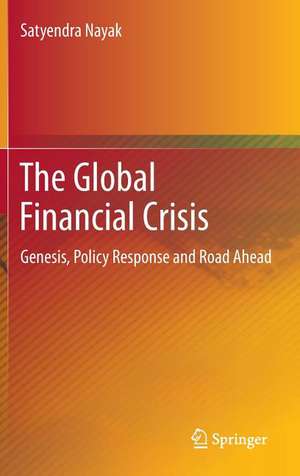The Global Financial Crisis: Genesis, Policy Response and Road Ahead
Autor Satyendra Nayaken Limba Engleză Hardback – 31 ian 2013
| Toate formatele și edițiile | Preț | Express |
|---|---|---|
| Paperback (1) | 362.97 lei 38-44 zile | |
| Springer India – iul 2015 | 362.97 lei 38-44 zile | |
| Hardback (1) | 398.74 lei 6-8 săpt. | |
| Springer India – 31 ian 2013 | 398.74 lei 6-8 săpt. |
Preț: 398.74 lei
Nou
Puncte Express: 598
Preț estimativ în valută:
76.31€ • 78.83$ • 63.51£
76.31€ • 78.83$ • 63.51£
Carte tipărită la comandă
Livrare economică 25 martie-08 aprilie
Preluare comenzi: 021 569.72.76
Specificații
ISBN-13: 9788132207979
ISBN-10: 8132207971
Pagini: 320
Ilustrații: XII, 306 p.
Dimensiuni: 155 x 235 x 23 mm
Greutate: 0.67 kg
Ediția:2013
Editura: Springer India
Colecția Springer
Locul publicării:New Delhi, India
ISBN-10: 8132207971
Pagini: 320
Ilustrații: XII, 306 p.
Dimensiuni: 155 x 235 x 23 mm
Greutate: 0.67 kg
Ediția:2013
Editura: Springer India
Colecția Springer
Locul publicării:New Delhi, India
Public țintă
Professional/practitionerCuprins
Part I- The Crisis: Micro-Macro Perspective.- Chapter1- Pathology of the Crisis.- Chapter 2- Sub-Prime Debt Imbroglio : Risks-Rewards of Financial Sophistication.- Chapter 3- Policy Response.- Chapter 4- Why Is the Economy Not Taking Off?.- Chapter 5- Euro-Sclerosis: Causation and Control.- Part II- Evolutionary Economics: A Systemic View.- Chapter 6- Benign Neglect of Dollar: Bretton Woods and its Demise.- Chapter 7- Enter The Globalization : Paradigm Shift.- Chapter 8- Great Crash and Depression : Relook.- Part III- Structural Gaps.- Chapter 9- Metamorphosis of American Capitalism.- Chapter 10- Downfall of Communism : God That Failed.- Chapter 11- Structural Shifts.- Chapter 12- US Savings Gap Vs Global Liquidity Reflux.- Part IV- Looking Ahead.- Chapter 13- Conundrum of Financial Markets : Measuring Risks and Mapping Regulation.- Chapter 14- Rediscovering Keynes.- Chapter 15- New Bretton Woods : Agenda for Global Economic Reform.
Notă biografică
Dr. Satyendra S. Nayak is an independent financial advisor and consultant. His experience stems from over 30 years of working in Banking and Mutual Fund industry, covering working in operations, international finance, project financing, foreign exchange, mutual fund management, equity and debt investments, portfolio management, and economic and investment research and strategy. He received his Ph.D. in International Economics and Finance from the University of Bombay, India. He is also a Professor at ICFAI Business School in Mumbai in the Centre for Advanced Banking and Finance Studies. He has published several articles and papers on India’s balance of payments, exchange rate of rupee, Euro Dollar market, behavior of US Dollar, international finance, Indian capital markets, stock market and mutual funds, US financial crisis and Keynesian economics. His earlier book ‘Global Monetary Experience and India’ won the Bhateja Memorial Award for the best book in economics in India in 1995. His second book ‘Globalization and the Indian Economy: Roadmap to Convertible Rupee’ was published by Routledge in 2008. He submitted a report on Roadmap for Fuller Convertibility of Indian Rupee to the Reserve Bank of India in 2006 and a number of recommendations made in the convertibility report were accepted by the Official Committee. He has addressed several national and international seminars, workshops and training programs in India and abroad on exchange rates, foreign exchange, international banking and euro currency market, capital markets, investment management, emerging markets, country funds, mutual funds, economic environment, budget and other related topics. He was a Member of Study Team appointed by the Asian Development Bank in 1988 on the Reform of Indonesian Capital Market.
Textul de pe ultima copertă
The Financial Crisis, though originating in the US, is global and comparable with the Great Depression of the 1930s. The book takes both micro and macro view of the crisis. It examines the evolution of the global monetary system and looks at the crisis from a systemic angle. It examines the institutional changes in American capitalism and market mechanisms. The dynamics of the market and its cyclical characters are discussed. It examines the structural changes in the US economy. The role of globalization and international funds flow, their changing character and the growing interdependence among nations have been examined. At the micro level, the book discusses the subprime market and the gaps in the system that created the crisis. It deals with the supervisory structure and growing influence of the derivatives market and the synthetic products that are threatening the financial system. It also analyzes the fundamental changes in the global trading and payments patterns, which are influencing the US balance of payments and the US dollar. The secular changes in the structure of the US economy are impacting the global economy. The work deals with the measures taken to resolve the crisis both in the US and on a global scale. The reforms necessary to avoid the recurrence of the crisis are outlined. The study aims to underline these factors and draw a perspective for the US dollar. It is also proposed to draw a scenario for a more efficient and equitable global monetary system with a role for the US dollar along with a new vehicle for international payments and finance. This would also include the reform of the global economic system and the IMF. The special feature of the book is that it takes a holistic view of the problem. The systemic and macro issues are discussed in addition to its microanalysis.
Caracteristici
Takes a novel and holistic view of the global problem and proposes a comprehensive agenda for the reform of the global economy It introduces a new concept, ‘The Niagara Effect’ in financial markets, and highlights why financial markets are different than others, i.e., why they are more volatile and need better regulation Analyses the metamorphosis of American capitalism, compares the current crisis to the Great Depression of the 1930s and discusses the US savings gap vs. the global liquidity glut















